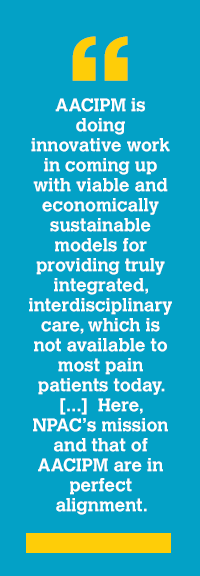What is the National Pain Advocacy Center?
 The National Pain Advocacy Center (NPAC) is new nonprofit organization whose mission is to advance the health and human rights of people with pain. It is an alliance of clinicians, scientists, health policy and human rights experts, and people with lived experience of pain or addiction. You can read more about us at nationalpain.org.
The National Pain Advocacy Center (NPAC) is new nonprofit organization whose mission is to advance the health and human rights of people with pain. It is an alliance of clinicians, scientists, health policy and human rights experts, and people with lived experience of pain or addiction. You can read more about us at nationalpain.org.
We are a policy-focused advocacy group. We envision a world in which pain is treated equitably and effectively, so that all people living with pain have the opportunity to lead full and productive lives.
In addition to our governing board, NPAC has two large councils: (1) a Science and Policy Advisory Council made up of professionals with a wide range of backgrounds, and (2) a Community Leadership Council made of people with lived experience. People with lived experience are at the center of everything we do and in every level of our organization.
Why did you decide to create this?

Kate Nicholson, JD, President & Founder, National Pain Advocacy Center
Many of us involved with NPAC have worked together over the past few years fighting bad policies. Everything we have accomplished has been a team effort. It seemed important given the scope of the change we want to see for people with pain for us to collaborate in more than an ad hoc way on select projects – and that a formal organization would have a greater force multiplier effect.
When thinking about the current needs through your legal and policy lens, and as a person living with chronic pain, what would you say is top priority in your work?
Right now, our immediate priority remains correcting one-size-fits-all policymaking on opioids that has led to significant barriers to care for people who require medical use of opioids. We continue to hear from patients every day who can’t find a doctor who is willing to treat them, cannot fill legitimate prescriptions, or are involuntarily or abruptly tapered off of opioid medication on which they previously relied.
 My own advocacy started in 2017 out of concerns about these harms. Since that time, we’ve had a Human Rights Watch report outlining the harms, studies showing that the majority of primary care providers will not see a prospective patient who uses opioids to manage pain and that more than 80% are reluctant to, and studies on opioid cessation practices showing that these practices can destabilize patients and even increase their risk of death. Public health authorities like the CDC have come out against strict, one-sized policies limiting prescribed opioids as misuse of its guideline, and both the FDA and HHS have come out against abrupt opioid cessation practices. But none of that seems to be filtering down to the lives of actual patients.
My own advocacy started in 2017 out of concerns about these harms. Since that time, we’ve had a Human Rights Watch report outlining the harms, studies showing that the majority of primary care providers will not see a prospective patient who uses opioids to manage pain and that more than 80% are reluctant to, and studies on opioid cessation practices showing that these practices can destabilize patients and even increase their risk of death. Public health authorities like the CDC have come out against strict, one-sized policies limiting prescribed opioids as misuse of its guideline, and both the FDA and HHS have come out against abrupt opioid cessation practices. But none of that seems to be filtering down to the lives of actual patients.
And politicians are still proposing strict limits. CARA 2.0, for example, is about to be reintroduced with a federal 3-day limit to initial opioid prescriptions – and the biggest problem with that is studies of similar limits in the states show that prescribing drops for all patients and not only for initial prescriptions.
One reason I am in these spaces is to make it very clear that there are still some patients for whom prescribed opioids remain essential. Chronic pain is a large umbrella category that also includes progressive, degenerative diseases and a range of conditions and severities. One size certainly cannot fit all.
You are an advocate for better access to multidisciplinary, person-centered, multimodal, integrative pain management. What was your journey like when searching for this and how do you hope it can change for others?
I was lucky enough to be treated in old-fashioned multidisciplinary pain management programs in the 1990s – one at the National Rehabilitation Hospital in Washington, D.C., and one at Johns Hopkins University. But I wasn’t transferred to pain management initially; like many chronic pain patients, I slogged through the medical system going from specialist to specialist. During that time, I read voraciously about pain and sought out a variety of treatment modalities including things like acupuncture and psychological tools like biofeedback and relaxation therapies, which definitely helped me. Once transferred to formal pain management, I had access to a much larger range of options. Even with those options, however, I still required prescribed opioids to work and function in circumstances in which my mobility and ability to sit or stand were severely limited. But I never only used prescribed opioids – I always used them in combination with other modalities. And this sort of integrated and multimodal pain care is simply not readily available to people with pain today.
How do you see NPAC and AACIPM continuing to collaborate meaningfully?
AACIPM is doing innovative work in coming up with viable and economically sustainable models for providing truly integrated, interdisciplinary care, which is not available to most pain patients today. Poor payer coverage is a significant barrier to many care modalities, and integrative treatments especially are often “boutique-like,” or only available to those who afford to pay out of pocket for the services. The range of available options needs to be expanded and equitably available. Here, NPAC’s mission and that of AACIPM are in perfect alignment.
But truly patient-centered care means giving patients access to a range of treatment options – sort of like what I received at multidisciplinary pain clinics in the 1990s, where options often include medications, interventions, behavioral health care, and integrative care. It cannot be an either/or situation. Unfortunately, I have seen efforts to elevate coverage for things like massage or chiropractic services come at the expense of coverage of medication. This happened in a proposed Medicaid plan in Oregon in which integrative care was to be covered but in a way that meant that about 100,000 patients on long-term opioid therapy would lose coverage of their medication. Many of us involved in NPAC fought and finally succeeded in defeating that policy.
Nor should patients be forced to try a lot of options that really are not appropriate for them as a pre-condition to receiving treatments that are. Coverage matters, but attention to the details of how those expanded modalities become covered also matters.
So, one way that NPAC and AACIPM can work together is to ensure that patient-centeredness and effective and equitable pain care is always the first priority in policies designed to expand access to integrative care.
What are you currently working on?
Right now, we are busy launching, introducing ourselves, and creating collaborations with like-minded groups, but we are also responding to notices for public comment, speaking at conferences, and working at the state and federal level to fight some of the bad policies we mentioned above.
Is there anything else that we should know about that you’re working on at the federal level now – or about your roles on many important committees, such as the new CDC workgroup?
As I mentioned, we have concerns about several opioid bills soon to be introduced to Congress, and we have met with legislators about those concerns in coordination with other groups like the Drug Policy Alliance and other disability rights groups. I also worked on a letter that will soon go to Congress about these concerns, that is signed by 100 of the top disability rights groups. This letter, which NPAC signed and which I helped draft, is hosted by the National Council on Independent Living, where I am co-chair of its Chronic Pain/Opioids Task Force. I am on the CDC workgroup that will respond to CDC’s draft revision of its Guideline, because what is issued by the CDC will have significant and far-reaching implications for the policy environment. I’m also working on a Task Force with Health Women that is focused in disparities related to women and pain care.

kate sounds like your doing good work. I am on disability have been 6-7 yr. went to pain clinic for 6 yr.for this time was givin 3 Narco 1000 and 3 Tramodol 50mg. to take weather i needed or no , they hadn to be tacken for the drug test I took every mounth.never been in troble with drugs ,every mounth was strange.after all the test i had one they said did no have tramadol in it was just cut off. Thought I was going to die.I just had open heart surgery and they give me Tylonol 3 for pain. no one will help me. I have a poor lifestyle ,can,t do much. Don’t have a lot to loose,very angry